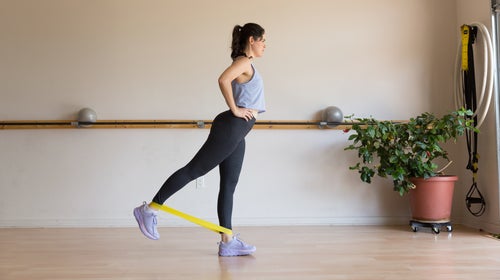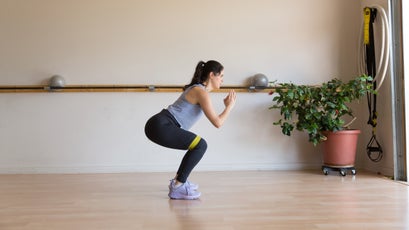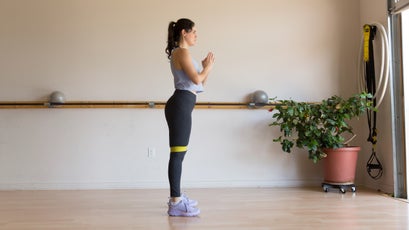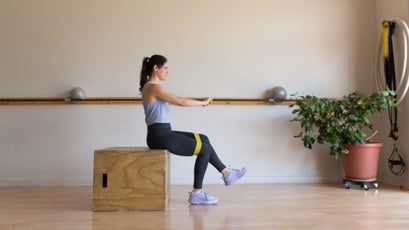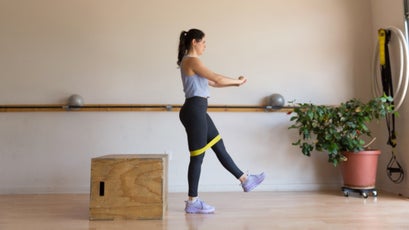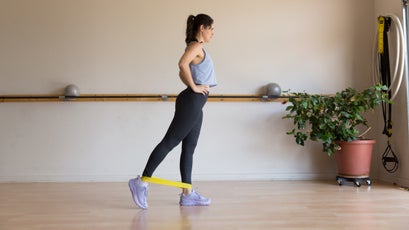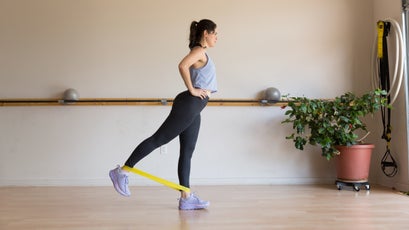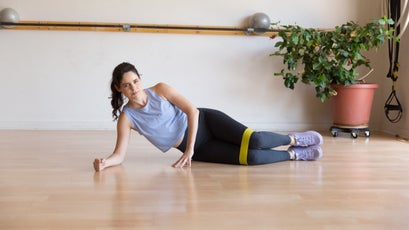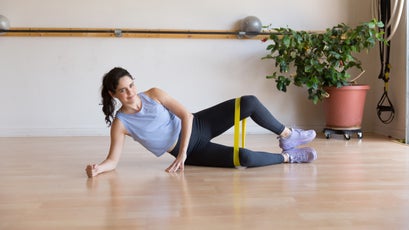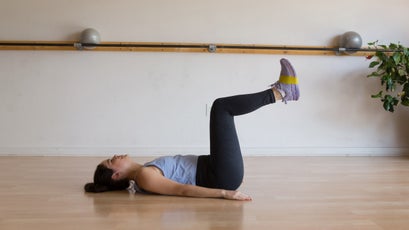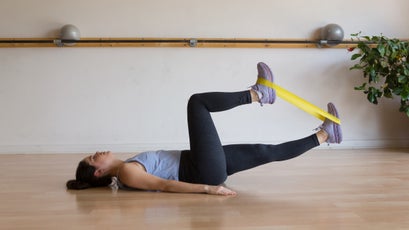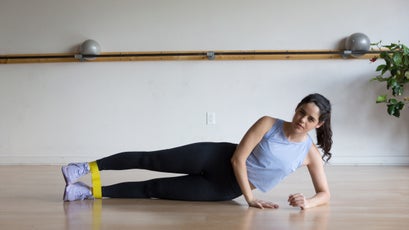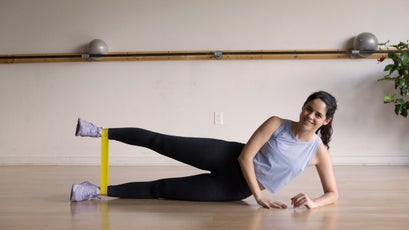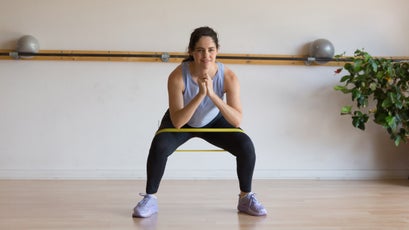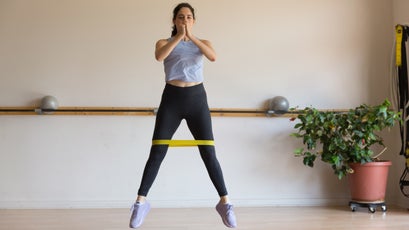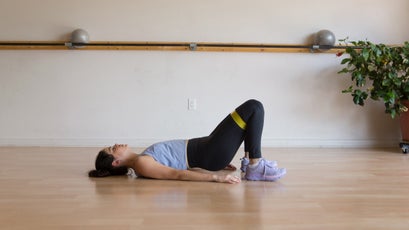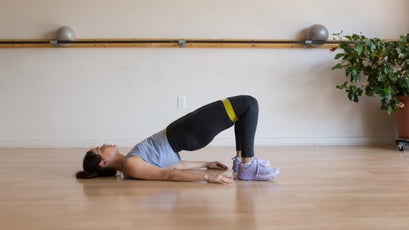Pumping iron isnÔÇÖt the only way to strengthen your legs. Weight training typically┬átargets the big gunsÔÇöthe quads, hamstrings, and glutei┬ámaximiÔÇöand neglects┬áthe smaller muscles critical for balance and joint stability, such as the hip abductors and┬áadductors, the flexors, and┬áthe obliques. Resistance band workouts are one of the best ways to work every muscle in the lower body, and you can do it anywhere.
, a National Academy of Sports MedicineÔÇôcertified personal trainer and an endurance coach with ,┬áand Brian Slaman, the director of precision training at , use and coach with resistance bands all the time. So we reached out to them for a sampling of the best leg-specific resistance-band workout moves.
The Exercises
- Lateral Band Steps
- One and One-Quarter Squats
- Single-Leg Stands
- Standing Glute Kickbacks
- Clamshells
- Runner’s Extensions
- Side-Lying Leg Lifts
- Squat Jacks
- Monster Walk
- Hip Bridges
Read on for how to do these ten resistance-band moves for the lower body.
The Resistance Band Workout
Do these exercises as a circuit. Complete one set of each with a one-minute rest between rounds. For a total leg day, start with three to four rounds of four to six exercises (try to balance out the target muscle groups, cycling through exercises that work different parts of the leg). If paired with upper-body exercises, pick three or four moves. Add more exercises and rounds as you get stronger. All youÔÇÖll need is a set of looped resistance bands (also known as mini bands).
Focus on proper form and not the number of repetitions. ÔÇťFor all of the exercises,ÔÇŁ Slaman┬ásays, ÔÇťkeep your core engaged so your back stays supported.ÔÇŁ
How to Choose the Right Resistance Band
Resistance bands come in different weights, typically ranging from extra light to ultraheavy. Some exercises are harder than others, and youÔÇÖll likely need to switch between different bands. The right band is the one that lets you complete 12 to 15 reps, working to get in those last reps but all with good form. If your form breaks before 12 reps, pick a lighter band. If you can easily complete 15 or more reps, move to the next level of resistance. You can double or triple up on bands if you donÔÇÖt have a wide range of weights or if you need the extra resistance.
The Resistance Band Workout Moves

Lateral-Band Steps
What they do: Strengthen the hip-abductor muscles (the gluteus medius, gluteus minimus, and tensor fasciae latae) and quads.
How to do them: Place a resistance band around both legs, and position it just above the knees (easier) or around the ankles (harder). Assume a quarter-squat position, with your feet pointed forward, hip-width apart. With the right foot, step right roughly 12 inches, and then, with control, step in with the left foot the equivalent distance so that your feet are back to a hip-width distance apart. Repeat in the opposite direction, and continue alternating steps side to side.
Maintain an athletic stance (donÔÇÖt stand up between steps) and keep┬átension in the band throughout the exercise. You should feel this on the outside of your hips and thighs. For an extra quad workout, perform the exercise from a deeper squat (knees bent to around 90 degrees)┬áwithout standing up between steps.
Reps: 12 to 15 on each side. Alternate directions every rep.
One and One-Quarter Squats
What they do: Strengthen the glutes, quads, and hamstrings, while engaging the hip-abductor muscles to train correct knee position and stability.
How to do them: Place the band above your knees and enter an athletic stance, with your feet shoulder-width apart, your chest upright, and your core engaged. Squat until your knees are bent to around 90 degrees (for more difficulty, go lower if you have hip mobility and can maintain good form). From the bottom of the squat, stand up one-quarter of the total distance, and then lower once again, like a mini squat within the squat, before standing all the way up to complete one repetition. Drive your knees outward against the band throughout the movement.
Reps: 12 to 15.
Single-Leg Stands
What they do: Strengthen the quads and glutei maximi, while engaging the glutei medii to train correct knee position and stability.
How to do them: Place the band above your knees. Sit on the edge of a bench or chair, ideally one at a height where your knees are bent to 90 degrees when sitting (the higher the seat, the easier). Tilt your torso forward slightly so that your chest is in front of your hips. Then lift one foot off the floor by an inch or so, and with the opposite foot firmly planted on the ground, stand up on that one leg until it is fully extended. Slowly return to a seated position for one repetition. Keep a consistent hip-width space between your knees throughout the movement.
Knee position is key. On the standing leg, focus on keeping your knee in line with your leg by pushing out against the band instead of allowing it to collapse or dip inward. ÔÇťIn general, when your knee collapses inward, that is because your quad and inner thigh are overcompensating for a weak gluteus medius,ÔÇŁ says Ligler. That can stress the knee joint over time. This exercise activates the gluteus medius to train knee stabilization during a single-leg standÔÇöa common movement pattern when hiking, running hills, or climbingÔÇöand itÔÇÖs a great way to prevent knee pain.
Reps: 12 to 15 on each side. Either alternate legs every rep (easier), or complete all reps on the same leg, lightly touching the seat but not fully sitting down, before switching sides (harder).
Standing Glute Kickbacks
What they do: Strengthen the glutes and hamstrings.
How to do them: Place the band around your ankles, and stand with your feet hip width apart. Engage your core muscles, shift your weight onto one leg, and with the opposite leg, slowly kick backward about six to eight inches. Reverse the movement with control, and with your raised foot, gently tap the ground just behind your planted foot. This equals one repetition.
Focus on balance and form. Stable, level hips are key. If your hips dip or twist, or if your lower back arches in compensation, youÔÇÖre likely kicking back too far┬áor using too heavy a resistance band. Your glutes and hamstrings should be doing all of the work here.
Reps: 12 to 15 on each side. Complete all reps on one leg, then switch to the other.
Clamshells
What they do: Strengthen the glutei medii and obliques.
How to do them: Place the band above your knees, and lie on your side, with your knees bent to 90 degrees. Prop your head up on your hand, rest it on your biceps, or support yourself with your lower arm. Engage your core, keep your feet pressed together, and drive your top knee toward the ceiling as far as you can without compensating form. Slowly bring it down again for one repetition.
Keep your hips stacked and perpendicular to the floor throughout the exercise. ÔÇťIf you tilt your pelvis back, itÔÇÖs an indication that youÔÇÖve done too many reps┬áor you need a lighter resistance,ÔÇŁ says Slaman.
Reps: 12 to 15 on each side. Complete all reps on one side first before doing the other side.
RunnerÔÇÖs Extensions
What they do: Strengthen the abdominals, hip flexors, and quads.
How to do them: Lie on your back, and loop the band around the center of both feet. Then lift your feet off the ground so that your knees and hips are bent to 90-degree angles and your shins are parallel to the ceiling. Keep your feet and knees hip width apart to maintain tension in the band. Tighten your core, and hold one leg firmly in place (the anchor leg) while you press against the band to fully extend the opposite leg. Slowly reverse the movement for one repetition. Flex your foot on the anchor leg to prevent the band from sliding off.
The anchor leg does all the work here, and your goal is to keep it perfectly stabilized while it holds the tension created by the band and the extension leg. ÔÇťWhen the anchor leg breaks, meaning youÔÇÖre not able to continue to hold a 90-degree angle at your hip and behind your knee, thatÔÇÖs when youÔÇÖre done on this exercise,ÔÇŁ says Ligler.
Reps: 12 to 15 on each side. Alternate sides every rep.
Side-Lying Leg Lifts
What they do: Strengthen the hip-abductor muscles.
How to do them: Place the band above your knees (easier) or around your ankles (harder). Lie on your side with your legs straight and stacked. Prop your head up on your hand, rest it on your biceps, or support yourself with your lower arm. Lift your upper leg toward the ceiling as high as you can without hiking your hip, then slowly lower it for one repetition. Keep your upper leg in line with your bottom leg throughout the movement. Focus on tempoÔÇöslow and steadyÔÇöand good form.
Reps: 12 to 15 on each side. Complete all reps on one side first before doing the other side.
Squat Jacks
What they do: Target the glutei medii, quads, and calves.
How to do them: Place the band above your knees (easier) or around your ankles (harder). Assume a quarter-squat position, with your feet pointed forward, hip width apartÔÇölike you would for lateral-band steps. Jump your feet out to each side, approximately four to six inches, and immediately back to the starting position for one repetition. Continue as quickly as you can while keeping good form. Maintain a still upper body throughout the exercise. Your torso and head should essentially remain in place while your legs do all the work.
Reps: 12 to 15.
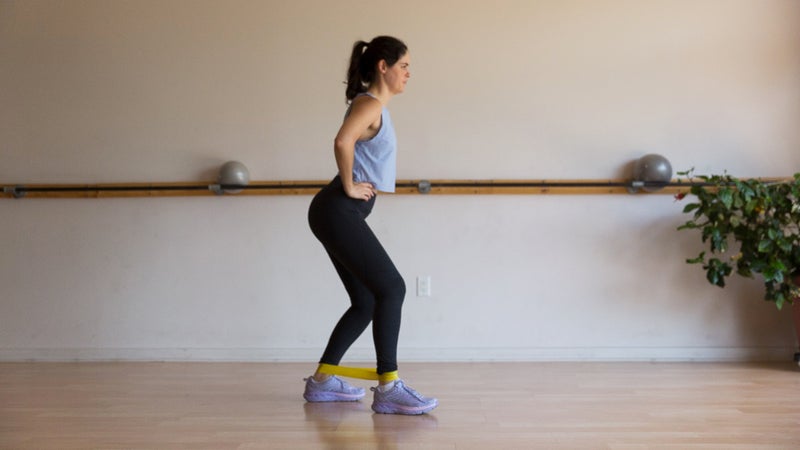
Monster Walk
What it does: Targets the glutei maximi.
How to do it: Place the band around your ankles. Stand with your feet hip width apart, engage your core, bend your knees slightly, and hinge forward at the hips to enter an athletic stance. Then take alternating steps backward (each step should be roughly eight to ten inches in length) while maintaining an equal distance between your feet and tension in the band. Focus on your hips: they should stay square (facing forward) and level throughout the exercise.
If your hips begin to twist, youÔÇÖre likely fatigued or taking too large of steps. If thatÔÇÖs the case, take smaller steps or switch to a lighter resistance band.
Reps: 12 to 15 on each side.
Hip Bridges
What they do: Target the glutes and hamstrings.
How to do them: Place the band above your knees. Lie on your back, with your feet flat on the floor, hip width apart. Engage your abs and squeeze your glutes as you press down through your heels to lift your pelvis off the floor, until your knees reach a 90-degree bend. Slowly reverse the movement for one repetition. Push your knees out against the band to keep them in line with your shoulders and feet throughout the movement.
Make it harder by lifting one foot off the ground an inch and pushing solely with the opposite leg. Alternate reps.
Reps: 12 to 15.
For another excellent Resistance Band workout, check out our ultimate resistance band workout video.╠ř
